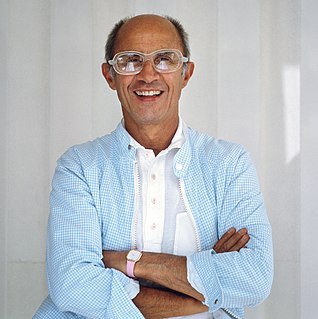Related Research Articles

Sir Norman Bishop Hartnell, KCVO was a leading British fashion designer, best known for his work for the ladies of the royal family. Hartnell gained the Royal Warrant as Dressmaker to Queen Elizabeth The Queen Mother in 1940, and Royal Warrant as Dressmaker to Queen Elizabeth II in 1957.

Raymond "Ossie" Clark was an English fashion designer who was a major figure in the Swinging Sixties scene in London and the fashion industry in that era. Clark is now renowned for his vintage designs by present-day designers.

A crinoline is a stiff or structured petticoat designed to hold out a woman's skirt, popular at various times since the mid-19th century. Originally, crinoline was described as a stiff fabric made of horsehair ("crin") and cotton or linen which was used to make underskirts and as a dress lining.

André Courrèges was a French fashion designer. He was particularly known for his streamlined 1960s designs influenced by modernism and futurism, exploiting modern technology and new fabrics. Courrèges defined the go-go boot and along with Mary Quant, is one of the designers credited with inventing the miniskirt.

Madeleine Vionnet was a French fashion designer. Vionnet trained in London before returning to France to establish her first fashion house in Paris in 1912. Although it was forced to close in 1914 at the outbreak of the First World War, it re-opened after the war and Vionnet became one of the leading designers in Paris between the Wars (1919-1939). Vionnet was forced to close her house in 1939 and retired in 1940.
Celia Birtwell, CBE, is a British textile designer and fashion designer, known for her distinctive bold, romantic and feminine designs, which are influenced by Picasso and Matisse, and the classical world. She was well known for her prints which epitomised the 1960s/70s. After a period away from the limelight, she returned to fashion in the early 21st century.
John Bates is an English fashion designer who, working as Jean Varon, was part of the boutique scene that blossomed in London in the 1960s.

Emanuel Ungaro was a French fashion designer who founded the eponymous fashion house in 1965.

Fashion in the 1970s was about individuality. In the early 1970s, Vogue proclaimed "There are no rules in the fashion game now" due to overproduction flooding the market with cheap synthetic clothing. Common items included mini skirts, bell-bottoms popularized by hippies, vintage clothing from the 1950s and earlier, and the androgynous glam rock and disco styles that introduced platform shoes, bright colors, glitter, and satin.
Alfred Radley was a British clothing manufacturer best known for founding Radley Fashions and his association with the Quorum Boutique and fashion designer, Ossie Clark.
Betty Jackson, is an English fashion designer based in London, England. She was born in Lancashire. In 2007, her success in British fashion was recognised with first an MBE in the Queen's Birthday Honours 1987 and later with a CBE for "services to the fashion industry." She is also known for designing many of the outrageous costumes worn by Edina and Patsy on the 1990s hit television comedy Absolutely Fabulous.
Ghost is a London fashion label founded in 1984 by Tanya Sarne. It is known for classic vintage clothing-influenced viscose crêpe, satin and georgette designs, which are modified slightly each season to keep them up to date, but do not follow trends. The Design Museum in London described the introduction of the Ghost dress as "one of those quiet revolutions" where the significance of an event in fashion history goes almost unnoticed at first.

Kiki Byrne was a Norwegian-born, London-based fashion designer who is mainly remembered as Mary Quant's rival on the King's Road in the late 1950s and 1960s.
Alice Pollock is a British fashion designer and retailer who founded the boutique Quorum, which featured the work of fellow designers Ossie Clark and Celia Birtwell, and later started the male modelling agency English Boy in London.

Peter Russell (1886–1966) was a London-based English fashion designer and a founder member of the Incorporated Society of London Fashion Designers. Running a major couture house from the 1930s to the early 1950s, he has been described as a: "designer of beautiful, jauntily sophisticated women's suits".
Stirling Cooper was a London-based fashion wholesaler and retailer that, along with brands such as Biba, Quorum, Browns and Clobber, helped to redefine UK fashion in the late 1960s.

Maison Margiela, formerly Maison Martin Margiela, is a French luxury fashion house headquartered in Paris and founded in 1988 by Belgian designer Martin Margiela. The house produces both haute couture-inspired artisanal collections and ready-to-wear collections, with the former influencing the designs of the latter. Product lines include womenswear, menswear, fine jewelry, footwear, objects, fragrance, and home goods, among others. Known for deconstructive and avant-garde designs with unconventional materials, Maison Margiela has traditionally held live shows in unusual settings, for example empty metro stations and street corners. Models' faces are often obscured by fabric or long hair to direct attention to the clothes and design. With Maison Martin Margiela going public in 2002, Margiela resigned as creative designer in 2009 and John Galliano was appointed to the role in 2014. The company has collaborated on displays and designs with Barneys New York, Converse, G-Shock Opening Ceremony, Hermès, H&M, L’Oreal, and Swarovski.
Sheilagh Brown is a British fashion designer who began her career in the 1960s, as part of the Swinging London scene. She was among the designers for Stirling Cooper, working subsequently at Coopers and Quorum, before establishing the label Barnett and Brown with Sheridan Barnett.
Jeffrey Rogers established his eponymous company in the 1970s in Margaret Street, Soho, with a staff of three. Over time, his company grew to become a large international concern; by 1988 it had a turnover of £25 million and exported 15 per cent of production outside the UK.

John Flett was a British fashion designer who achieved early success with his own brand before designing briefly for Claude Montana. He died of a heart attack at the age of 27, while working in Florence.
References
- 1 2 3 4 5 6 7 Almond, Kevin; Mallett, Daryl F. "Barnett, Sheridan". fashionencyclopedia.com. Retrieved 1 August 2014.
- ↑ Brown, Sheilagh. "Sheilagh Brown and Sheridan Barnett". Very Magazine. No. 15. Retrieved 5 August 2014.
- 1 2 "Sheilagh Brown". vimeo.com. Retrieved 5 August 2014.
- ↑ staff. "Ossie Clark". Vogue. Retrieved 6 August 2014.
- ↑ biography. "Ossie Clark". fashionmuseum.fitnyc.edu. FIT. Retrieved 6 August 2014.
- ↑ Polan, Brenda; Tredre, Roger (2009). The Great Fashion Designers. Oxford: Berg. p. 173. ISBN 9781847882288 . Retrieved 5 August 2014.
- ↑ "Dress of the Year". fashionmuseum.co.uk. Retrieved 14 June 2015.
- ↑ Morris, Bernadine (16 October 1984). "A new vitality marks openings in London". The New York Times. Retrieved 1 August 2014.
- ↑ Morris, Bernadine (18 March 1986). "London's new mood: classic dashing fashion". The New York Times. Retrieved 1 August 2014.
- ↑ Frankel, Susannah (1 October 2011). "Christian Dior shows there's life after Galliano – and before Jacobs". The Independent. Retrieved 5 August 2014.